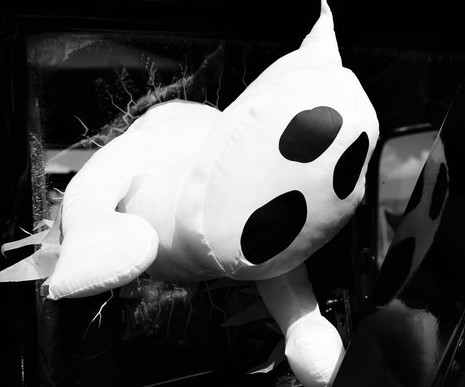Reviewing: Parapsychology: A Beginner’s Guide by Caroline Watt
The Motive:
Sometimes, when I reach for my laptop, CARL distracts me with slow groaning noises and chain rattling. Occasionally, he even wears a white sheet in protest. He becomes so troubled when supernatural elements creep into my fiction that he extemporises on an old Scottish prayer:
“From ghoulies and ghosties and long-leggedy beasties and things that go bump when you type… Good Lord, deliver us!”
The Evidence:
After moving to Edinburgh for my first job and before the rising tide of corporate responsibility swallowed me entirely, I considered the night classes available at Edinburgh University. I was intrigued to find a course in Parapsychology, the scientific study of paranormal phenomena. Edinburgh University had been home to the Koestler Chair of Parapsychology since 1985, and that course proved a fascinating introduction to a subject that attempts rigorous consideration of what might lie beyond the boundaries of current knowledge. At that time, Professor Richard Wiseman was part of the unit studying for a PhD on The Psychology of Deception, an example of this controversial discipline scrutinising itself and seeking conventional explanations for the phenomena it studies.
At the end of the course the tutors recruited some students for ESP research. In the movie Ghostbusters students earned an electric shock for every incorrect Zener card, so the fact I signed up at all should tell you how desperately I needed to fill my evenings. But I remember the real life ESP study as a gentle affair, utilising relaxation and mental imagery techniques to assess impact on the scoring in Ganzfeld sessions. Ganzfeld testing applies mild sensory deprivation to a receiver in the hope of improving focus on the thoughts of a sender viewing hidden targets in a remote location. One of the people running that study was Caroline Watt, now the holder of the Koestler Chair at Edinburgh. Although I’d had no contact with parapsychology after my curious few months in the early nineties, when I noticed that the now Professor Watt had written this book, I decided the information might prove useful in my writing.
But what has the paranormal to do with crime fiction anyway? For many authors, nothing at all, but some sub-genres of crime and mystery are very much inflected with the weird. A strong candidate for the original fictional detective was created by that Godfather of Gothic, Edgar Allen Poe, when his C. Auguste Dupin first investigated the Murders in The Rue Morgue. Over the following decades other writers (including Sheridan Le Fanu, Algernon Blackwood and William Hope Hodgson) established the genre of occult detectives and that combination of uncanny investigation continues in a more or less unbroken line to the present day. Prominent examples include John Connolly with his horror-flecked Charlie Parker mysteries, or James Oswald and his Inspector McLean series. The modern graphical occult noir of DC Comics Hellblazer has been penned by traditional crime writers – both Ian Rankin and Denise Mina have taken a shot. Since even the best selling crime-writer of all time Agatha Christie turned her hand to supernatural fiction it is difficult to ignore the pattern.
It prompts the question of what would tempt such world-class mystery-solvers towards the definitively inexplicable? Might it be that the crime writer’s bedrock themes of justice, evil, redemption, death and survival, are all barely a hair’s breadth from metaphysics? Storytelling in that region will tempt many authors to cross the line, and nor should they apologise for it, whatever CARL thinks. Perhaps the last word on this question comes from Stephen King, who in the foreword to his book Night Shift gave his answer to any who asked why he wrote horror stories: “Why do you assume I have a choice?”
That lengthy detour aside, we finally return to our book under review. The first point worth making is that between these covers you’ll find neither credulous jump-scares nor endless debunking. This even-handed overview of a controversial field is a definite strength, with is no obvious editorial line around belief or disbelief of the various phenomena discussed (my suspicion is that the author is instinctively more Scully than Mulder, but that’s scientists for you).
After a brief history of parapsychology from the dawn of Spiritualism through to the modern day, the book divides into three sections. The first deals with testing psychic claimants in the area of so called macro PK – metal bending, levitation and materialisation of matter. The fact this section includes a lengthy discussion of psychic fraud will give you a sense of the chequered history in this area. The second section covers near-death and out-of-body experiences alongside hauntings and apparitions, before examining the psychological factors that might predispose towards belief in anomalous experiences of these types. The final section considers laboratory research on telepathy, clairvoyance, precognition and mental influence on physical systems (such as random number generators) or biological systems (for example in healing). In the lab, while effects generally shrink as methodologies improve to exclude trickery and information leakage, a number of studies continue to produce results interesting enough to justify ongoing research.
While it is fair to say that hard evidence remains elusive, that isn’t the whole story. The author makes it clear that one key benefit of parapsychology, operating as it does under a hail of controversy, lies in pioneering best-practice approaches to evidence. The discipline produced:
- The first record of statistical analysis and randomisation in behavioural science in 1904.
- The adoption of meta-analysis to assess evidence offered by multiple studies in 1940.
- The adoption of publication measures to eliminate QRPs (questionable research practices) in 1978.
And if the continuing evaluation of paranormal claims has value in itself, that can only be a good thing: critical examination of beliefs outside the boundaries of known science will be required until our species achieves knowledge nirvana and has nothing left to learn. Call me a pessimist, but I doubt that will happen any time soon!
The Verdict:
Writers (and their characters) seeking to risk reputation (or worse, their very soul) by dabbling with the supernatural would benefit from this well-written, compact and intelligent guide to the study of the paranormal over the last century or so.



Recent Comments